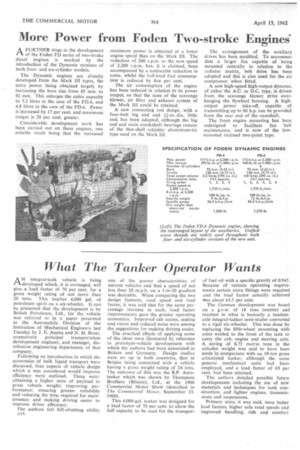What The Tanker Operator Wants
Page 66

If you've noticed an error in this article please click here to report it so we can fix it.
AN integral-tank vehicle is being developed which, it is envisaged, will give a load factor of 70 per cent. for a gross weight rating of not more than 20 tons. This implies 4,000 gal. of petroleum spirit on a six-wheeler. It can be presumed that the development is by British Petroleum, Ltd., for the vehicle was referred to in a paper presented to the Automobile Division of the Institution of Mechanical Engineers last Tuesday by J. E. Austin and N. H. Brear, respectively principal transportation development engineer, and manager, distribution engineering department, of that company.
Following an introduction in which the economics of bulk liquid transport were discussed, four aspects of vehicle design which it was considered would improve efficiency were outlined. These were: obtaining a higher ratio of payload to gross vehicle weight; improving performance: ensuring greater reliability and reducing the time required for maintenance; and making driving easier to improve driver efficiency.
The authors felt hill-climbing ability n16 one of the poorer characteristics of current vehicles and that a speed of not less than 20 m.p.h. on a 1-in-20 gradient was desirable. When comparing the two design features, road speed and load factor, it was said that for the same percentage increase in each, load factor improvements gave the greater operating economics. Improved cab access, seating and vision and reduced noise were among the suggestions for making driving easier.
The practical effects of applying some of the ideas were illustrated by reference to prototype-vehicle development with which the authors had been associated in Britain and Germany. Design studies were set •up in both countries, that in Britain being concerned with a vehicle having a gross weight rating of 24 tons. The outcome of this was the B.P. Autotanker which was shown by Thompson Brothers (Bilston), Ltd., at the 1960 Commercial Motor Show (described in The Commercial ,VIotor, September 23. 1960).
This 4,000-gal. tanker was designed for a load factor of 70 per cent, to allow the full capacity to be used for the transport
of fuel oil with a specific gravity of 0.945. Because of various operating requirements certain extra fittings were required and the load factor actually achieved was about 65.5 per cent.
The German development was based on a g.v.w. of 18 tons (metric) and resulted in what is basically a tandemaxle integral-tanker semi-trailer converted to a rigid six-wheeler. This was done by replacing the fifth-wheel mounting with arms welded to the front of the tank to carry the cab, engine and steering axle: A saving of 0.75 metric tons in the unladen weight was said to have been made in comparison with an 18-ton gross articulated tanker, although the same general mechanical units had been employed, and a load factor of 63 per cent, had been attained.
The authors detailed possible future developments including the use of new materials and techniques for tank construction, and lighter engines, transmissions and suspensions.
Primary aims, it was said, were better load factors, higher safe road speeds and improved handling, ride and comfort




















































































































